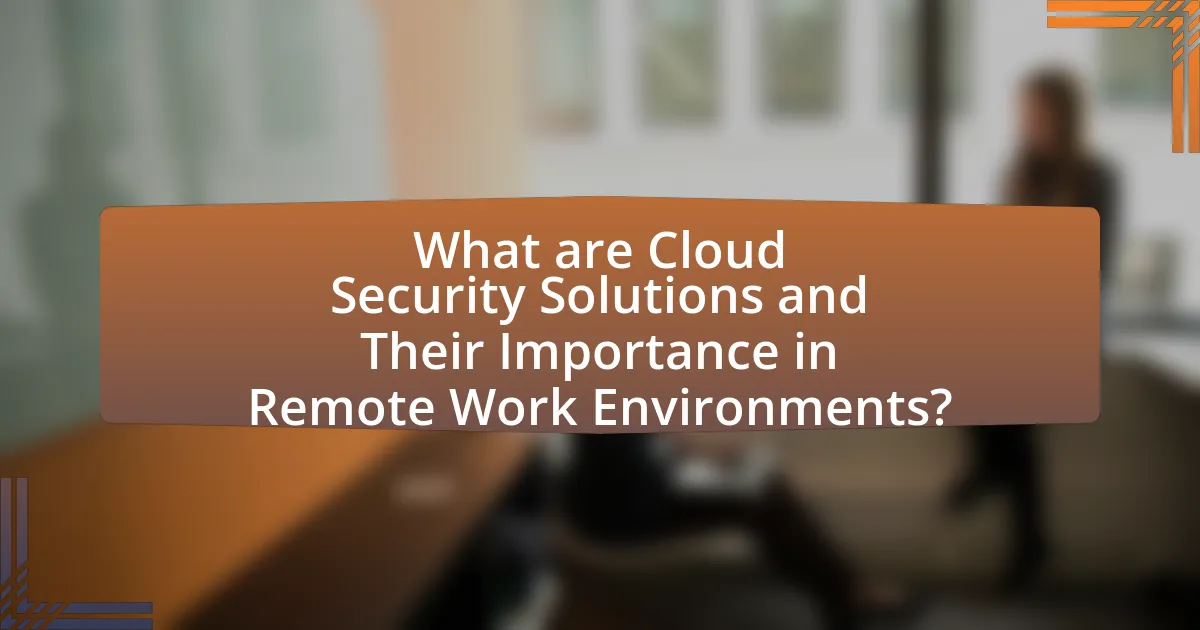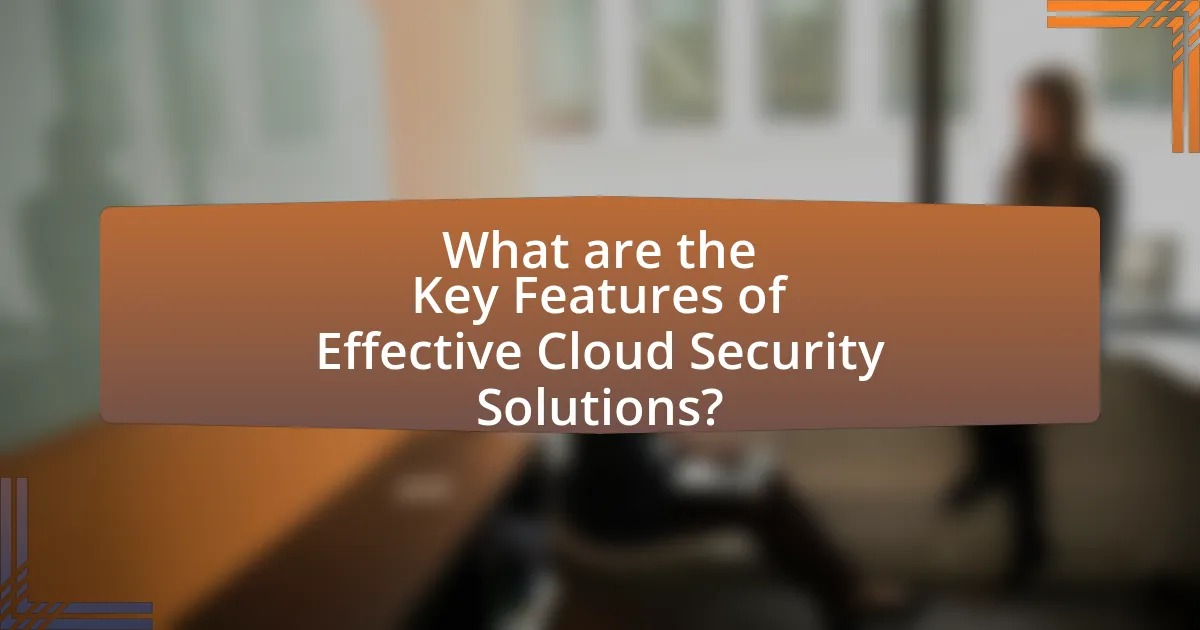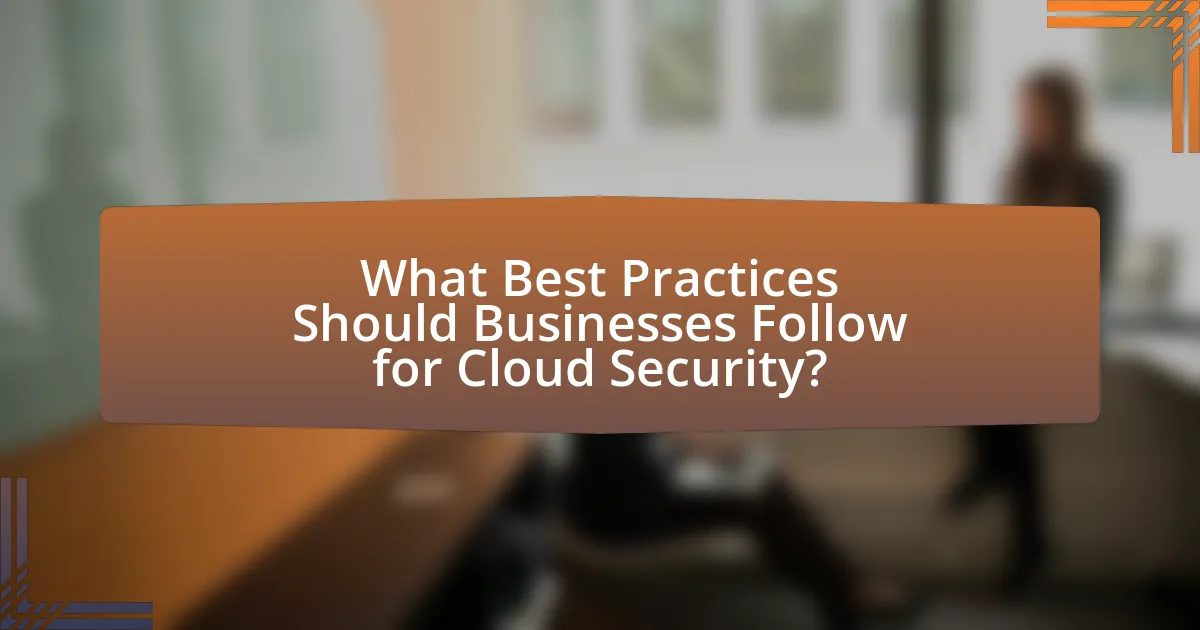Cloud security solutions are essential technologies and practices that protect data, applications, and services in cloud environments, particularly in remote work settings. With a significant rise in cyber threats, as evidenced by reports indicating that 93% of organizations faced cloud security incidents, the implementation of robust security measures is critical. This article explores how cloud security solutions safeguard business data through encryption, access controls, and continuous monitoring, while also addressing various threats such as data breaches and insider threats. Additionally, it highlights best practices for enhancing cloud security, including the importance of multi-factor authentication, regular audits, and employee training to mitigate risks associated with remote work vulnerabilities.

What are Cloud Security Solutions and Their Importance in Remote Work Environments?
Cloud security solutions are technologies and practices designed to protect data, applications, and services hosted in cloud environments. Their importance in remote work environments is underscored by the increasing reliance on cloud services for collaboration and data storage, which exposes organizations to various cybersecurity threats. According to a report by McAfee, 93% of organizations experienced a cloud security incident in the past year, highlighting the critical need for robust cloud security measures. These solutions include encryption, identity and access management, and continuous monitoring, which collectively safeguard sensitive business data from unauthorized access and breaches, ensuring compliance with regulations and maintaining business continuity.
How do Cloud Security Solutions protect business data?
Cloud security solutions protect business data by implementing multiple layers of security measures, including encryption, access controls, and continuous monitoring. Encryption secures data both at rest and in transit, ensuring that unauthorized users cannot access sensitive information. Access controls restrict data access to authorized personnel only, reducing the risk of data breaches. Continuous monitoring detects and responds to potential threats in real-time, allowing for immediate action to mitigate risks. According to a report by Gartner, organizations that adopt cloud security solutions can reduce the risk of data breaches by up to 60%, demonstrating their effectiveness in safeguarding business data.
What types of threats do Cloud Security Solutions mitigate?
Cloud Security Solutions mitigate various types of threats, including data breaches, insider threats, account hijacking, insecure APIs, and DDoS attacks. Data breaches occur when unauthorized access leads to the exposure of sensitive information, which can be prevented through encryption and access controls. Insider threats arise from employees misusing their access, and solutions can monitor user behavior to detect anomalies. Account hijacking involves unauthorized access to user accounts, which can be mitigated through multi-factor authentication. Insecure APIs can expose vulnerabilities, and security solutions can implement proper authentication and validation measures. DDoS attacks aim to overwhelm services, and cloud security can provide traffic management and mitigation strategies to maintain service availability.
How do these solutions ensure data integrity and confidentiality?
Cloud security solutions ensure data integrity and confidentiality through encryption, access controls, and regular audits. Encryption protects data at rest and in transit, making it unreadable to unauthorized users. Access controls restrict data access to authorized personnel only, reducing the risk of data breaches. Regular audits help identify vulnerabilities and ensure compliance with security standards, thereby maintaining the integrity of the data. For instance, according to a 2021 report by the Cloud Security Alliance, organizations that implemented robust encryption and access management saw a 50% reduction in data breach incidents.
Why is Cloud Security crucial for remote work?
Cloud security is crucial for remote work because it protects sensitive business data from unauthorized access and cyber threats. With the increase in remote work, employees access company resources from various locations and devices, making them more vulnerable to attacks. According to a report by Cybersecurity Ventures, cybercrime is projected to cost the world $10.5 trillion annually by 2025, highlighting the urgent need for robust cloud security measures. Implementing cloud security solutions ensures data encryption, secure access controls, and continuous monitoring, which are essential for safeguarding information in a distributed work environment.
What challenges do businesses face in securing data remotely?
Businesses face several challenges in securing data remotely, primarily due to increased vulnerabilities associated with remote access. The reliance on various devices and networks, often outside the control of the organization, heightens the risk of data breaches. According to a report by IBM, remote work has led to a 20% increase in security incidents, highlighting the need for robust security measures. Additionally, the lack of consistent security protocols across different locations and devices complicates data protection efforts. Furthermore, employees may inadvertently expose sensitive information through unsecured Wi-Fi networks or phishing attacks, which have surged by 600% during the pandemic, as reported by the Cybersecurity and Infrastructure Security Agency. These factors collectively create a challenging landscape for businesses aiming to secure their data remotely.
How does remote work increase vulnerability to data breaches?
Remote work increases vulnerability to data breaches primarily due to the reliance on unsecured home networks and personal devices. Employees working remotely often connect to the internet through Wi-Fi networks that lack robust security measures, making them susceptible to interception by cybercriminals. According to a report by Cybersecurity & Infrastructure Security Agency (CISA), 90% of organizations experienced a data breach due to remote work vulnerabilities during the COVID-19 pandemic. Additionally, personal devices may not have the same level of security software or updates as corporate devices, further increasing the risk. This combination of factors creates an environment where sensitive business data is more easily exposed to unauthorized access and exploitation.

What are the Key Features of Effective Cloud Security Solutions?
Effective cloud security solutions feature robust data encryption, comprehensive access controls, continuous monitoring, and incident response capabilities. Data encryption protects sensitive information both at rest and in transit, ensuring that unauthorized users cannot access it. Comprehensive access controls, including multi-factor authentication and role-based access, limit user permissions and enhance security. Continuous monitoring involves real-time analysis of network traffic and user behavior to detect anomalies and potential threats. Incident response capabilities ensure that organizations can quickly address and mitigate security breaches, minimizing potential damage. These features collectively enhance the security posture of businesses operating in remote work environments, safeguarding critical data against evolving cyber threats.
How do authentication and access controls enhance security?
Authentication and access controls enhance security by ensuring that only authorized users can access sensitive data and systems. Authentication verifies the identity of users through methods such as passwords, biometrics, or multi-factor authentication, while access controls determine the permissions granted to those authenticated users. According to a study by the Ponemon Institute, organizations that implement strong authentication measures can reduce the risk of data breaches by up to 80%. This demonstrates that effective authentication and access controls are critical components in safeguarding business data, especially in remote work environments where the risk of unauthorized access is heightened.
What role does multi-factor authentication play in data protection?
Multi-factor authentication (MFA) significantly enhances data protection by requiring multiple forms of verification before granting access to sensitive information. This additional layer of security mitigates the risk of unauthorized access, as it combines something the user knows (like a password) with something the user has (such as a mobile device for a verification code). According to a report by the Cybersecurity & Infrastructure Security Agency, implementing MFA can block over 99% of automated cyberattacks, demonstrating its effectiveness in safeguarding data.
How can businesses implement role-based access controls effectively?
Businesses can implement role-based access controls (RBAC) effectively by clearly defining user roles and permissions aligned with job functions. This involves conducting a thorough analysis of organizational needs to categorize roles based on access requirements, ensuring that employees receive the minimum necessary permissions to perform their tasks.
Furthermore, utilizing cloud security solutions can streamline the management of RBAC by automating the assignment of roles and monitoring access patterns. For instance, according to a study by Gartner, organizations that implement automated RBAC systems can reduce security incidents by up to 30%, demonstrating the effectiveness of this approach in enhancing data protection in remote work environments. Regular audits and updates of roles and permissions are also essential to adapt to changing business needs and to maintain compliance with security policies.
What encryption methods are commonly used in Cloud Security Solutions?
Commonly used encryption methods in Cloud Security Solutions include Advanced Encryption Standard (AES), RSA (Rivest-Shamir-Adleman), and Transport Layer Security (TLS). AES is widely adopted for its efficiency and security, utilizing key sizes of 128, 192, or 256 bits, making it suitable for encrypting data at rest and in transit. RSA is a public-key encryption method that secures data transmission by using a pair of keys, ensuring that only authorized users can decrypt the information. TLS, which is essential for securing communications over networks, encrypts data during transmission, protecting it from eavesdropping and tampering. These methods are integral to maintaining data confidentiality and integrity in cloud environments, as evidenced by their widespread implementation across various cloud service providers.
How does data encryption protect sensitive information?
Data encryption protects sensitive information by converting it into a coded format that is unreadable without a decryption key. This process ensures that even if unauthorized individuals access the data, they cannot interpret it, thereby safeguarding confidentiality. For instance, the Advanced Encryption Standard (AES) is widely used and recognized for its effectiveness in securing data, as it employs complex algorithms that make unauthorized access extremely difficult. According to a report by the Ponemon Institute, organizations that implement encryption experience a 50% reduction in the risk of data breaches, highlighting its critical role in protecting sensitive information in various environments, including remote work settings.
What are the differences between at-rest and in-transit encryption?
At-rest encryption secures data stored on a device or server, while in-transit encryption protects data being transmitted over a network. At-rest encryption ensures that data is unreadable without the appropriate decryption key, safeguarding it from unauthorized access when it is not actively being used. In contrast, in-transit encryption uses protocols like TLS (Transport Layer Security) to encrypt data as it travels between devices, preventing interception during transmission. Both methods are essential for comprehensive data protection, addressing different vulnerabilities in the data lifecycle.

What Best Practices Should Businesses Follow for Cloud Security?
Businesses should implement multi-factor authentication (MFA) as a best practice for cloud security. MFA significantly reduces the risk of unauthorized access by requiring users to provide two or more verification factors, which can include something they know (password), something they have (security token), or something they are (biometric verification). According to a report by Microsoft, enabling MFA can block over 99.9% of account compromise attacks. Additionally, businesses should regularly update and patch their cloud services to protect against vulnerabilities, as outdated software can be an easy target for cybercriminals. Regular audits and monitoring of cloud environments are also essential to detect and respond to potential threats promptly.
How can businesses assess their current cloud security posture?
Businesses can assess their current cloud security posture by conducting a comprehensive security assessment that includes evaluating their cloud configurations, access controls, and compliance with industry standards. This assessment typically involves utilizing automated tools to scan for vulnerabilities, reviewing security policies and procedures, and performing regular audits to ensure adherence to best practices. According to a 2021 report by the Cloud Security Alliance, 70% of organizations that implemented regular security assessments reported improved security posture and reduced risk of data breaches.
What tools can help in evaluating cloud security effectiveness?
Tools that can help in evaluating cloud security effectiveness include security information and event management (SIEM) systems, cloud access security brokers (CASBs), and vulnerability assessment tools. SIEM systems, such as Splunk and IBM QRadar, aggregate and analyze security data from various sources, enabling organizations to detect and respond to threats in real-time. CASBs, like McAfee MVISION Cloud and Netskope, provide visibility and control over cloud services, ensuring compliance and data protection. Vulnerability assessment tools, such as Qualys and Nessus, identify security weaknesses in cloud configurations and applications, allowing organizations to remediate issues proactively. These tools collectively enhance the ability to assess and improve cloud security posture effectively.
How often should businesses conduct security audits?
Businesses should conduct security audits at least annually. This frequency aligns with industry best practices and helps identify vulnerabilities in systems and processes. According to the National Institute of Standards and Technology (NIST), regular audits are essential for maintaining compliance and ensuring the effectiveness of security measures. Additionally, organizations experiencing significant changes, such as new technology implementations or regulatory updates, should perform audits more frequently to address emerging risks.
What are the common pitfalls to avoid in cloud security?
Common pitfalls to avoid in cloud security include inadequate access controls, misconfigured cloud settings, and lack of data encryption. Inadequate access controls can lead to unauthorized access, as seen in the 2020 Capital One breach, where a misconfigured firewall allowed a hacker to access sensitive data of over 100 million customers. Misconfigured cloud settings often result in data exposure; for instance, a 2019 report indicated that 70% of cloud security failures stemmed from misconfigurations. Lastly, failing to encrypt data both in transit and at rest increases vulnerability to data breaches, as unencrypted data can be easily intercepted.
How can businesses prevent misconfigurations in cloud settings?
Businesses can prevent misconfigurations in cloud settings by implementing automated configuration management tools. These tools continuously monitor and enforce compliance with security policies, reducing human error, which is a leading cause of misconfigurations. According to a report by the Cloud Security Alliance, 70% of cloud security incidents are attributed to misconfigurations, highlighting the importance of proactive measures. Additionally, regular training for employees on cloud security best practices further mitigates risks associated with misconfigurations.
What are the risks of neglecting employee training on cloud security?
Neglecting employee training on cloud security significantly increases the risk of data breaches and cyberattacks. Without proper training, employees may inadvertently expose sensitive information through phishing attacks, weak passwords, or misconfigured cloud settings. According to a report by IBM, human error is a contributing factor in 95% of cybersecurity incidents, highlighting the critical need for ongoing education in cloud security practices. Additionally, organizations may face compliance issues and financial losses due to regulatory penalties, as well as damage to their reputation, which can result from a lack of trained personnel capable of safeguarding cloud environments.
What practical steps can businesses take to enhance cloud security?
Businesses can enhance cloud security by implementing multi-factor authentication (MFA) for all user accounts. MFA significantly reduces the risk of unauthorized access, as it requires users to provide two or more verification factors to gain access to cloud services. According to a report by Microsoft, enabling MFA can block over 99.9% of account compromise attacks.
Additionally, businesses should conduct regular security assessments and audits to identify vulnerabilities in their cloud infrastructure. These assessments help organizations understand their security posture and address potential weaknesses proactively. The Cloud Security Alliance emphasizes that continuous monitoring and assessment are critical for maintaining robust cloud security.
Furthermore, data encryption both at rest and in transit is essential. Encrypting sensitive data ensures that even if unauthorized access occurs, the information remains unreadable without the decryption key. The National Institute of Standards and Technology (NIST) recommends encryption as a fundamental practice for protecting sensitive information in cloud environments.
Lastly, providing employee training on cloud security best practices is vital. Educating staff about phishing attacks, secure password management, and safe data handling can significantly reduce human error, which is a leading cause of security breaches. The Ponemon Institute found that human error accounts for 23% of data breaches, highlighting the importance of training in enhancing overall security.
How can regular updates and patches improve security?
Regular updates and patches improve security by addressing vulnerabilities in software that could be exploited by attackers. When developers release updates, they often include fixes for known security flaws, which helps to close potential entry points for cyber threats. For instance, a report by the Cybersecurity and Infrastructure Security Agency (CISA) indicates that 85% of successful cyber attacks exploit known vulnerabilities for which patches are available. By consistently applying these updates, organizations can significantly reduce their risk of data breaches and enhance their overall security posture.
What role does incident response planning play in cloud security?
Incident response planning is crucial in cloud security as it establishes a structured approach to identifying, managing, and mitigating security incidents. This planning enables organizations to respond swiftly to breaches, minimizing potential damage and data loss. According to a report by the Ponemon Institute, organizations with an incident response plan can reduce the cost of a data breach by an average of $1.23 million. Effective incident response planning also ensures compliance with regulatory requirements, thereby protecting the organization from legal repercussions.
